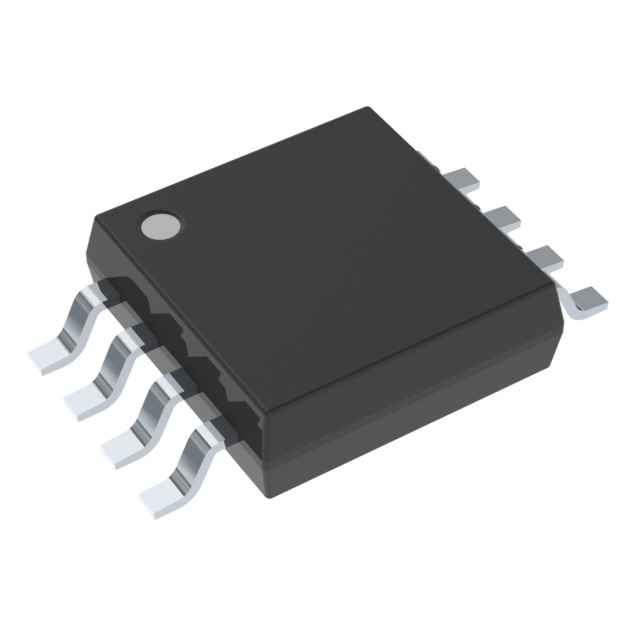Xem thông số kỹ thuật để biết chi tiết sản phẩm.

MAX9092AUA+T
Product Overview
- Category: Integrated Circuit (IC)
- Use: Amplifier
- Characteristics: Low-power, high-speed, rail-to-rail output, single-supply operation
- Package: 8-pin µMAX® package
- Essence: The MAX9092AUA+T is a low-power, high-speed amplifier designed for single-supply applications. It provides rail-to-rail output swing and operates from a single +2.7V to +5.5V supply voltage.
- Packaging/Quantity: The MAX9092AUA+T is available in an 8-pin µMAX® package. It is typically sold in reels of 2500 units.
Specifications
- Supply Voltage Range: +2.7V to +5.5V
- Input Offset Voltage: ±1mV (max)
- Gain Bandwidth Product: 50MHz (typ)
- Slew Rate: 40V/µs (typ)
- Input Bias Current: 1nA (typ)
- Quiescent Current: 500µA (typ)
- Operating Temperature Range: -40°C to +85°C
Pin Configuration
The MAX9092AUA+T has the following pin configuration:
```
| | --| IN- OUT |-- Pin 1: Output --| IN+ VCC |-- Pin 2: Positive Supply Voltage --| GND NC |-- Pin 3: Ground --| NC NC |-- Pin 4: Not Connected --| NC NC |-- Pin 5: Not Connected --| NC NC |-- Pin 6: Not Connected --| NC IN+ |-- Pin 7: Non-Inverting Input --| NC IN- |-- Pin 8: Inverting Input |___________| ```
Functional Features
- Low-power consumption
- High-speed operation
- Rail-to-rail output swing
- Single-supply operation
- Wide supply voltage range
- Low input offset voltage
- Low input bias current
Advantages and Disadvantages
Advantages: - Low power consumption makes it suitable for battery-powered applications. - High-speed operation enables fast signal processing. - Rail-to-rail output swing allows for maximum utilization of the supply voltage range. - Single-supply operation simplifies circuit design. - Wide supply voltage range provides flexibility in various applications. - Low input offset voltage ensures accurate amplification. - Low input bias current minimizes loading effects on the signal source.
Disadvantages: - Limited number of pins may restrict the number of external components that can be connected directly to the IC. - Not suitable for high-voltage applications due to the limited supply voltage range.
Working Principles
The MAX9092AUA+T is an operational amplifier (op-amp) that amplifies the input signal with high gain and provides a corresponding output. It operates from a single supply voltage, allowing for easy integration into various circuits. The rail-to-rail output swing ensures that the amplified signal covers the entire supply voltage range, maximizing the dynamic range of the output signal.
The low-power consumption of the MAX9092AUA+T makes it ideal for battery-powered applications where energy efficiency is crucial. The high-speed operation enables rapid signal processing, making it suitable for applications requiring fast response times.
Application Field Plans
The MAX9092AUA+T can be used in a wide range of applications, including but not limited to:
- Portable audio devices
- Sensor signal conditioning
- Battery-powered instrumentation
- Active filters
- Data acquisition systems
- Medical devices
- Communication systems
Alternative Models
Here are some alternative models that offer similar functionality to the MAX9092AUA+T:
- AD8605: Low-power, rail-to-rail output amplifier
- LT1677: Precision, low-noise, rail-to-rail output amplifier
- MCP6002: Low-power, rail-to-rail input/output amplifier
- OPA333: Single-supply, rail-to-rail input/output amplifier
- TS912: Low-power, rail-to-rail input/output amplifier
These alternative models can be considered based on specific application requirements and design constraints.
In conclusion, the MAX9092AUA+T is a versatile amplifier IC with low-power consumption, high-speed operation, and rail-to-rail output swing. Its wide supply voltage range and single-supply operation make it suitable for various applications. However, designers should consider alternative models based on their specific needs.
Liệt kê 10 câu hỏi và câu trả lời thường gặp liên quan đến ứng dụng MAX9092AUA+T trong giải pháp kỹ thuật
Sure! Here are 10 common questions and answers related to the application of MAX9092AUA+T in technical solutions:
Q: What is the MAX9092AUA+T? A: The MAX9092AUA+T is a high-speed, low-power operational amplifier (op-amp) designed for various applications in technical solutions.
Q: What is the supply voltage range for the MAX9092AUA+T? A: The supply voltage range for the MAX9092AUA+T is typically between 2.7V and 5.5V.
Q: What is the maximum bandwidth of the MAX9092AUA+T? A: The MAX9092AUA+T has a maximum bandwidth of 100MHz.
Q: Can the MAX9092AUA+T operate with a single power supply? A: Yes, the MAX9092AUA+T can operate with a single power supply.
Q: What is the input voltage range of the MAX9092AUA+T? A: The input voltage range of the MAX9092AUA+T extends from the negative supply rail to the positive supply rail.
Q: Does the MAX9092AUA+T have built-in protection features? A: Yes, the MAX9092AUA+T includes built-in protection against short-circuits and thermal shutdown.
Q: What is the typical quiescent current consumption of the MAX9092AUA+T? A: The typical quiescent current consumption of the MAX9092AUA+T is around 2.5mA.
Q: Can the MAX9092AUA+T drive capacitive loads? A: Yes, the MAX9092AUA+T is capable of driving capacitive loads up to 100pF.
Q: What is the operating temperature range for the MAX9092AUA+T? A: The operating temperature range for the MAX9092AUA+T is typically between -40°C and +85°C.
Q: Are there any evaluation boards or reference designs available for the MAX9092AUA+T? A: Yes, Maxim Integrated provides evaluation kits and reference designs for the MAX9092AUA+T, which can help in the development and testing of technical solutions.
Please note that these answers are general and may vary depending on specific datasheet specifications and application requirements.

